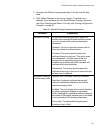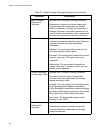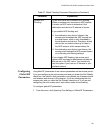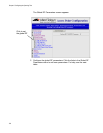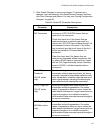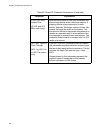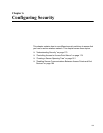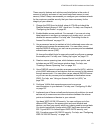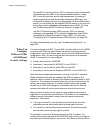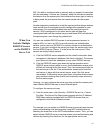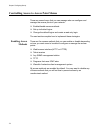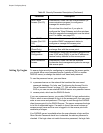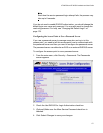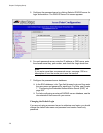AT-WA7500 and AT-WA7501 Installation and User’s Guide
171
These security features and solutions are listed below in the order of
amount of security and ease of use (most basic/least secure to most
secure). Allied Telesyn recommends you configure your wireless network
for the maximum possible security that you deem necessary for the
integrity of your network.
1. Change the SSID from its default value of ATILAN and check the
Disallow Network Name of ‘ANY’ check box. For help, see Chapter 4,
“Configuring the Radios” on page 96.
2. Enable/disable access methods. For example, if you are not using
telnet sessions to configure or manage your access point, you can
disable this access method. For help, see “Controlling Access to
Access Point Menus” on page 174.
3. Use a password server to maintain a list of authorized users who can
configure and manage the access points. You can either use an
external RADIUS server or you can use any access point’s embedded
authentication server (EAS).
Or change the default login for users who need to configure or manage
the access point. For help, see “Setting Up Logins” on page 176.
4. Create a secure spanning tree, which between access points, and
includes secure IAPP and secure wireless hops. For help, see
“Creating a Secure Spanning Tree” on page 181.
5. Use a RADIUS server to maintain an access control list (ACL), which is
a list of MAC addresses of end devices that can connect to the network
through access point. You can either use an external RADIUS server
or you can use any access point’s embedded authentication server
(EAS). For help, see “Using an Access Control List (ACL)” on
page 184.
6. Configure VLANs that separate secure and non-secure
communications in your network. For help, see “Configuring VLANs”
on page 187.
7. Implement one of these mutually-exclusive security solutions (on each
service set) to ensure secure communications between the access
points and wireless end devices in your network:
Use basic WEP 64/128/152 security. You can configure up to four
different WEP keys on the access point and most wireless end
devices, and then you specify which key is being used to encrypt data.
You should periodically change which WEP key these devices use.
802.11g and 802.11b radios support WEP 64/128 security, and
802.11a radios support 64/128/152 security. For help, see “Configuring
WEP 64/128/152 Security” on page 189.



